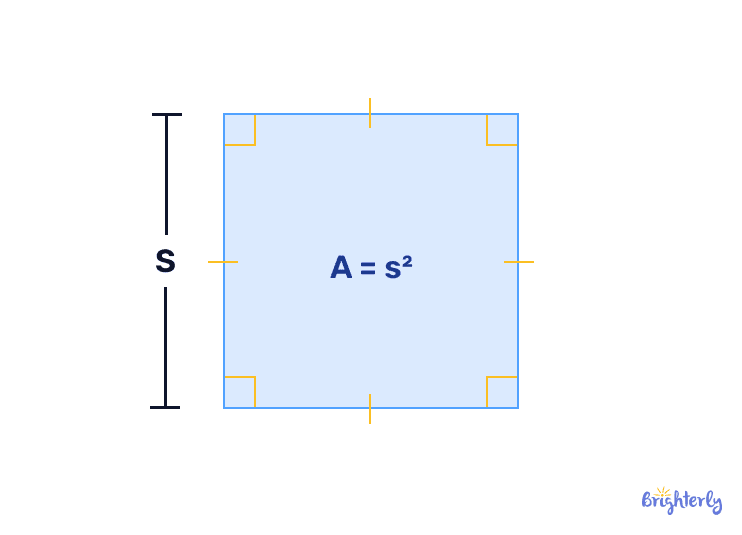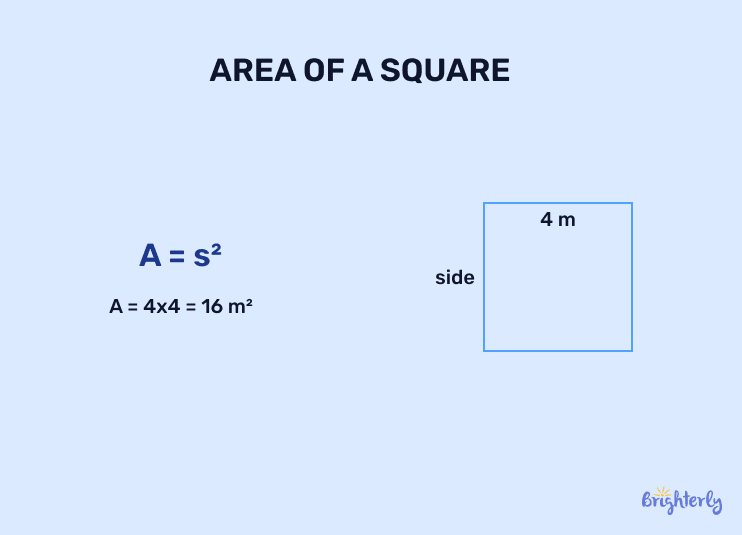Area of a Square – Definition, Formula, Examples
Updated on December 1, 2025
The square is a core shape in geometry, and you will learn all about its properties and features in the early stages of your geometry education.
One key property that you will work with a lot is area. The area is the space inside a square and can be calculated if you have the side lengths, perimeter, or diagonal information.
Here, we’ll cover everything you need to know about the area of squares. This will include what the area of a square is, the square area formula to work it out, and how to work it out depending on the information you already know about your square. Then, we’ll share some solved sample math questions to show you how to answer questions on the area of squares, before you answer some yourself!
Now, let’s get into everything you need to know about the area of a square for kids!
What is the area of square?
The area of a square is the space contained within a square. When it comes to expressing this property, you do that in square units. So if you have your measurements in inches, your area would be measured in square inches. Similarly, if it’s centimeters, your area will be in square centimeters.
Usually, you’ll use the side lengths of your square to quickly work out the area of the square. But, as you’ll discover later in this article, you can also solve it if you have other pieces of information, but you don’t know the side length!

Area of square formula
There is a simple formula that can help you work out the area of square quickly and easily. That formula for how to calculate area of a square is:
Area = side x side
This can also be expressed as area = side2, since we are multiplying the length of each side by itself. One fundamental property of the square is that all its sides are of equal length, so when you know the length of one side, you know the length of all of them!
How to find the area of a square?
To find the surface area of a square, you can use the formula of side x side = area. This formula is quick and easy to do. But what if you don’t know your square’s side lengths? Well, the good news is that if you have other information about your square, you can still work out the area!
Here, we’ll cover how to find the area of a square when you have three different pieces of information:
- How to calculate the area of a square if you know the perimeter
- How to calculate the square area if you know the side length
- How to calculate the area of a square if you know the diagonal length
Area of square when the perimeter of a square is given
If you know the perimeter of your square, you can use this to solve the area. We know that the perimeter of a square is the sum of its side lengths. This means you’ll be adding the same number to itself four times. Therefore, if you divide that number by 4, you will then calculate the length of its sides. Then, you can use your formula!
Let’s look at an example. If we have a square with a perimeter of 20 cm, we would divide that by 4.
20 cm ÷ 4 = 5 cm.
Then, we multiply our side length by itself to get the area of our square.
5 cm x 5 cm = 25 cm2
Area of square when the side of square is given
When you know the side lengths of your square, you only need to take one step to solve the area of your square. Let’s use the example of a square with side lengths of 9 inches and use our formula:
9 in x 9 in = 81 in2

Area of square when the diagonal of a square is given
The diagonal of a square is the length from one corner to the opposite corner — for example, the line from the bottom left corner to the top right. To work out the area of a square using the diagonal, you first use the diagonal to work out the side length using the formula d² ÷ 2. Once you have the side length, you can use your standard formula.
Let’s use the example of a square with a diagonal of 4 m.
42 ÷ 2 = 8 m
Then, we’ll use our area of a square formula to work out the area from this.
8 m x 8 m = 64 m2
Area of a square sample problems
Now, let’s take a look at some sample solved questions around the area of a square. We’ll share some problems below, along with the tactics required to solve them.
Solved math task 1
You have a square with a perimeter of 20 inches. Work out its area.
Answer
| 25 in2 |
First, you need to divide the perimeter measurement by 4 to get your side measurement:
20 in ÷ 4 = 5 in
Then, multiply that by itself (aka square it) to find area of square.
5 in x 5 in = 25 in2
Solved math task 2
You have a square with side lengths of 6 meters. Work out its areas.
Answer
| 36 m2 |
Because we know the side lengths of our square, we only need to use our area of a square formula to work out the answer:
6 m x 6 m = 36 m2
Solved math task 3
You have a square with a diagonal of 6 centimeters. Work out the square area.
Answer
| 50 cm2 |
First, we need to determine our side length from the diagonal. To do that, we square the diagonal and then divide the result by 2.
62 ÷ 2 = 18 cm
Then, we multiply our side length by itself, aka square it, to find our area.
18 cm x 18 cm = 324 cm2
Practice problems on the area of a square
Now that you have observed how to solve the area of a square with different information on your square given, it’s time to answer some questions yourself. Get a pen and paper and write down your answers — you can also write down your calculations, too!
- You have a square with a perimeter of 32 centimeters. Work out the area of this square and show your workings.
- You have a square with side lengths of 9 inches. Work out the area of this square and show your workings.
- You have a square with a diagonal length of 14 meters. Work out the area of this square and show your workings.
Conclusion
Now, you can consider yourself an expert in the area of squares! We’ve answered questions like “What is the area of a square?”, “How do you find the area of a square?” and “What if I don’t know the side length of a square”?
We’ve also given you some solved questions to show you how to answer questions around finding the area of a square, before we gave you some practice problems so you could try it out for yourself. Now, no matter what measurement you know — whether that’s the side, the perimeter, or the diagonal — you will be able to work out the area of any given square.
Now, you are prepared for more complex geometry concepts, like different types of shapes and working out their area. When you’re asking, “How do you find the area of a shape?”, knowing how to work out the area of a square will provide the foundational knowledge you need to answer that question. This skill is essential if you are to master geometry!
Frequently asked questions on area of square
What is the area of a square?
The area of a square is the space that is enclosed between the four sides of a square. It is always expressed in square units and is generally worked out by squaring the length of your sides (hence the square units!). You can also use the perimeter and the diagonal to calculate.
What is the formula for the area of a square?
The formula for area of a square is:
Side x side = area (which can also be expressed as side2)
You’ll also need to use additional formulas first if you know other measurements:
- Perimeter: perimeter ÷ 4 = side
- Diagonal: diagonal2 ÷ 2 = side
Then, use your main square area formula.
How to find area of a square?
To find the area of the square, you can use the area of a square formula. However, if you only know the perimeter, first divide it by 4 to get the side length. If you know the diagonal, square it and divide by 2 to get your side length.
What is the difference between the area and the perimeter of a square?
The difference between the area and the perimeter of a square is the measurements they represent. The area of a square is the space enclosed by all 4 sides and is measured in square units. The perimeter, meanwhile, is the sum of all the side lengths.
Is the formula for the area of a square the same for all squares?
Yes, the formula for the area of a square is the same for all squares. However, you must know the side length to use it. If you don’t know the side length but you do know the perimeter or the diagonal, you can use them to calculate the side length.






